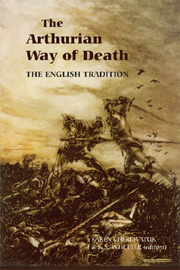Book contents
- Frontmatter
- Contents
- Illustrations and Tables
- Dedication
- List of Contributors
- Introduction
- Part I The early Tradition in england
- Part II Middle English Romance and Malory
- 4 ‘Hadet with an aluisch mon’ and ‘britned to noℨt’: Sir Gawain and the Green Knight, Death, and the Devil
- 5 Love and Death in Arthurian Romance
- 6 Death in the Margins: Dying and Scribal Performance in the Winchester Manuscript
- 7 The Legible Corpses of Le Morte Darthur
- 8 Malory and the Death of Kings: The Politics of Regicide at Salisbury Plain
- 9 ‘Layde to the Colde Erthe’: Death, Arthur's Knights, and Narrative Closure
- Part III Medieval Influence and Modern Arthuriana
- Index
- Arthurian Studies
8 - Malory and the Death of Kings: The Politics of Regicide at Salisbury Plain
from Part II - Middle English Romance and Malory
Published online by Cambridge University Press: 12 September 2012
- Frontmatter
- Contents
- Illustrations and Tables
- Dedication
- List of Contributors
- Introduction
- Part I The early Tradition in england
- Part II Middle English Romance and Malory
- 4 ‘Hadet with an aluisch mon’ and ‘britned to noℨt’: Sir Gawain and the Green Knight, Death, and the Devil
- 5 Love and Death in Arthurian Romance
- 6 Death in the Margins: Dying and Scribal Performance in the Winchester Manuscript
- 7 The Legible Corpses of Le Morte Darthur
- 8 Malory and the Death of Kings: The Politics of Regicide at Salisbury Plain
- 9 ‘Layde to the Colde Erthe’: Death, Arthur's Knights, and Narrative Closure
- Part III Medieval Influence and Modern Arthuriana
- Index
- Arthurian Studies
Summary
A commonplace in late Victorian Malory criticism held that the final confrontation between Arthur and Mordred on Salisbury Plain represented an example of sin coming home to roost. The House of Atreus was invoked by critics well into the second half of the twentieth century to illustrate the way in which the results of Arthur's incestuous affair with his sister produce the instrument of his own downfall, his son and nephew Mordred. Although the view that Arthur's kingdom is destroyed by sin is still current, twentieth-century Malory criticism also emphasizes the public results of Arthur's private tragedy: Arthur's and Guenevere's failure to produce a legitimate heir and Arthur's incestuous conception of Mordred cause the failure of a kingdom as well as a family. If the account of the Arthurian court's conflagration on Salisbury Plain gains force because its leaders represent a perversion of the normal father-son relationship, it is also powerful because they represent a distortion of a political relationship and a political ideal. The purpose of this chapter is to argue that the episodes of civil war in Malory's Morte Darthur that culminate in the mutual destruction of Arthur and his son Mordred reveal an abnormal picture of kingship as well as a flawed father-son relationship. Both Arthur and Mordred are crowned kings at the end of Le Morte Darthur. Their actions and characterizations during the civil wars that destroy Camelot expose a portrait of malfunctioning kingship on one hand and a perversion of kingship on the other.
- Type
- Chapter
- Information
- The Arthurian Way of DeathThe English Tradition, pp. 136 - 150Publisher: Boydell & BrewerPrint publication year: 2009

